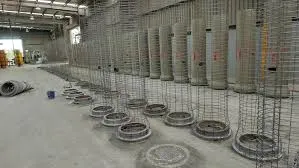Дек . 09, 2024 21:21 Back to list
Steel Casting Manufacturing Facilities and Their Key Features and Benefits
An Overview of Steel Casting Factories Processes and Innovations
Steel casting is a crucial manufacturing process that transforms molten steel into complex shapes and components. This method is widely used across various industries, including automotive, aerospace, construction, and heavy machinery. The importance of steel casting factories cannot be overstated, as they play a pivotal role in producing components that require high strength, durability, and resistance to wear and tear. This article explores the processes involved in steel casting, the advancements in technology, and the challenges faced by steel casting factories today.
The Steel Casting Process
The steel casting process generally involves several key steps pattern making, molding, pouring, cooling, and finishing. The process begins with creating a pattern, which is a replica of the final product. Patterns can be made from various materials, including wood, metal, or plastic, depending on the desired appearance and the volume of production.
Once the pattern is ready, it is placed in a mold, which is typically made from sand or metal. This mold is designed to withstand high temperatures and is capable of producing intricate shapes. The next step involves melting steel in a furnace, where the steel is heated to temperatures exceeding 1,500 degrees Celsius. Once the steel has melted, it is poured into the mold.
Cooling is a critical stage in the casting process. The molten steel solidifies as it cools, taking the shape of the mold. The cooling period can vary depending on the size and thickness of the cast piece. After sufficient cooling, the mold is broken away to reveal the cast component, which is still in a rough form.
The final stages of the steel casting process include finishing and treatment. This involves cleaning the casting, removing any imperfections, and performing secondary operations such as machining, heat treating, or surface finishing. These processes enhance the properties of the casting and ensure it meets the specifications required for its intended use.
Innovations in Steel Casting
Steel casting factories are continuously evolving, embracing new technologies to improve efficiency, quality, and safety. One significant advancement is the adoption of automation and computer numerical control (CNC) machining. Automated systems can perform repetitive tasks with precision, reducing labor costs and minimizing human error.
steel casting factories

Additionally, advancements in simulation software allow manufacturers to predict and resolve potential issues in the casting process before they occur. By modeling the flow of molten steel and analyzing cooling rates, manufacturers can optimize designs and minimize defects. This innovation leads to higher-quality castings and reduces material waste.
Furthermore, the industry is increasingly adopting advanced materials and techniques such as 3D printing for pattern production. This technology enables the rapid prototyping of complex designs, reducing the time and cost associated with traditional pattern making.
Challenges Facing Steel Casting Factories
Despite the advancements, steel casting factories face numerous challenges. One major issue is the environmental impact of steel production. The process generates significant CO2 emissions and waste, prompting factories to explore sustainable practices. Many are working towards implementing greener technologies, such as using electric arc furnaces, which are more energy-efficient and produce fewer emissions.
Another challenge is the fluctuating prices of raw materials. Steel prices are often volatile, influenced by global demand and supply chain disruptions. This can complicate budgeting and forecasting for casting operations.
Additionally, attracting skilled labor remains a concern. The steel casting industry requires specialized knowledge and training, and the current workforce is aging. Companies are investing in training programs and partnerships with educational institutions to cultivate new talent.
Conclusion
Steel casting factories are integral to modern manufacturing, producing critical components that support multiple industries. As technology advances, these factories continue to innovate processes and improve efficiencies. However, challenges such as environmental concerns and workforce issues must be addressed to ensure the industry’s sustainability and growth. Through a combination of technological integration and commitment to responsible practices, steel casting factories can enhance their contributions to the global economy while addressing the needs of future generations.
-
Durable Centrifugally Cast Iron Water Main Pipe
NewsAug.11,2025
-
Centrifugally Cast Iron Water Main Pipes for Reliability
NewsAug.10,2025
-
High-Quality Centrifugally Cast Iron Water Main Pipes
NewsAug.09,2025
-
Durable Cast Iron Water Main Pipe & Drainage Solutions
NewsAug.08,2025
-
Buy Cast Iron Pipe: Premium Ductile Iron & Drain Solutions
NewsAug.07,2025
-
Durable Cast Iron Water Main Pipe | Buy Ductile Pipe
NewsAug.06,2025


